| Reply to Thread New Thread |
|
|
|
|
#1 |
|
|
Can we classify 'HINDUSIM'as a religion or culture, I would opt out for the latter, because we do not have a "unified system of belief encoded in declaration of faith " like other major religion like Christianity Islam or Buddhism. Hinduism is formed of diverse traditions and has no single founder, it is a combination off various cultures with 'highly' contradicting views, scriptures and stories.. It has two main divisions 'Shivasism' (Shiva followers) and ' Vaishanvism', these kinds of divisions can be found in Christianity and Islam...
During 'Iron age of India' ShivLinga worships been the eldest practice known to man kind, it has been proved by many archaeologists and scholars alike. The introduction of Vaishnavism was introduced later after the invasion from 'Eastern Europe/ Persia' etc... In time, two of these cultures merged together to form tradition called 'Hinduism'... We (Hindus) have all the scientific proofs about the creation of the universe, life,etc.. from our ancient ‘Rishi’s and techniques for self realisation using Yoga and meditation to achieve such gaols, as far as I know, 'No religion or sect has proved this before'. , yet we have enormous amount of contradiction stories, puranas etc... Most Hindus don’t have clue about the tradition it self, unlike the Christians and Muslims.. We simply go to the temple to fulfil our ‘own’ needs and mourn about ‘our grief’ which is created by human itself, not by GOD. Majority of us have no clue about the ‘Shiva puran’ skanda purana;’ or Gita’.. This is not the case with Christians and Muslims. It is the responsibility of the authorities of the temple to preach the scriptures daily like in the church or mosque. What are your thoughts on this… [/b] |
|
|
|
|
#3 |
|
|
Hi Raghu..
[tscii]Can we classify 'HINDUSIM'as a religion or culture, I would opt out for the latter, because we do not have a "unified system of belief encoded in declaration of faith " like other major religion like Christianity Islam or Buddhism. Hinduism is formed of diverse traditions and has no single founder, it is a combination off various cultures with 'highly' contradicting views, scriptures and stories.. It has two main divisions 'Shivasism' (Shiva followers) and ' Vaishanvism', these kinds of divisions can be found in Christianity and Islam... We (Hindus) have all the scientific proofs about the creation of the universe, life,etc.. from our ancient ‘Rishi’s Scientific proofs? I am not sure if we have scientific proofs for the creation of the Universe etc. Could you be more clear here? Most Hindus don’t have clue about the tradition it self, unlike the Christians and Muslims.. We simply go to the temple to fulfil our ‘own’ needs and mourn about ‘our grief’ which is created by human itself, not by GOD. Majority of us have no clue about the ‘Shiva puran’ skanda purana;’ or Gita’.. This is not the case with Christians and Muslims. It is the responsibility of the authorities of the temple to preach the scriptures daily like in the church or mosque. One problem is that there is too much literature. Where does one begin? Ideally the starting points are the Itihaasas, Ramayana and Mahabharatha (more importantly). A lot of people know these stories, but inspite of all that even an iota of real understanding seems to be missing from our lives. There exist very few people who grasp the totality of just these Itihaasas, let alone the esoteric treatises of Hinduism. Also, we have the problem of language, where few people hardly ever learn Tamil or Sanskrit deeply enough to appreciate these ancient texts. And then finally there is the problem of over dependence and indoctrination. Moreover, Hinduism has not 'required/forced' people to do any special activities/rituals or develop a belief in anything. Ultimately each sect seems to stress of viewing all beings with equanimity and compassion. So a 'preaching' seems rather unnecessary. However, awareness of the foundational elements of Hinduism should be developed as you say. There are several avenues in Hinduism even in this modern world to hunt individually for knowledge, and for the deeply motivated seeker, the Guru himself shows the way to true freedom, which IMHO should be the sole aim. Honestly I think few people really understand or care for such a life (including among those who have a wide knowledge of the scriptures). Love and Light. |
|
|
|
|
#4 |
|
|
.
NO "ISM" LABEL... as Saivism or Vaishnawism or the like... EXCLUSIVELY APT ... ..Even as HINDU-ISM.!... ...for this LARGE-HEARTED... VEDIC-CULTURE of Human-Values.! Religions or various pursuits of God-Realisation are intended to BROADEN the HUMAN- OUTLOOK.... ....and UPLIFT the Mankind alone possessing the invaluable SOUL... by means of Applied Wisdom and Cultured Mind... ....towards EMANCIPATION OF HUMAN SOUL.... ....to ensure that Supreme Earthly birth... TRULY ENJOY his ROYAL OPPORTUNITY by all Senses... ...and NOT TO NARROW DOWN.... nor DIVIDE the One Global Humanity.! This Vedic-Religion... is the COMPRHENSIVE plus INTEGRAL FORM of ALL THE POPULAR WORLD RELIGIONS.! The Name of Vedic-Religion lablelled as HINDUISM... is in fact called as SANAATHANA-DHARMA... by its followers. ..which means ETERNAL RELIGION of God-stipulated COMMON Order for the sake of ENTIRE MANKIND... of any Age and Era.. How.? Better we approach and UNDERSTAND...Sri Ramakrishna Paramahamsa, Dr Annie Besant, Sri Krishna Chaithanya... and so on... ...to TRULY KNOW... what is Vedic-Culture... .... intended for EMANICIPATION OF HUMANITY. This Religion alone renders FULL LIBERTY to the devotees to worship and follow any God.... ...through any means amongst the wide options provided to avail... .... by Ones own choice and perception Although the different means may cause varied sorts of experience.... All the Results will be almost EQUAL... ....because the ultimate GOD IS ONE.!!! That One Supreme God... takes up several forms and shapes... in the manner the devotee believes and follows... say Vedas. Who is that ONE GOD... Hiding behind several Gods.? First of all... Such a logical Question and Thought on SUPREME GOD... are unnecessary for a Layman- Devotee. However if anyone is anxious to know... then let him / her just think awhile... and OBSERVE... ...why at the beginning and end of Vedic chanting... it is prayed as...HARIHI OHM.!!! Who is that Hari.? Why chanted so..? That will clarify and answer all our Doubts and Questions.... .... as well as on One and all the Questions on ANY GOD and FORM.... ....meant for SUPER-HUMAN Protection and Surveilence for Mankind.!!! Can we classify 'HINDUSIM'as a religion or culture, I would opt out for the latter, because we do not have a "unified system of belief encoded in declaration of faith " like other major religion like Christianity Islam or Buddhism. Hinduism is formed of diverse traditions and has no single founder, it is a combination off various cultures with 'highly' contradicting views, scriptures and stories.. It has two main divisions 'Shivasism' (Shiva followers) and ' Vaishanvism', these kinds of divisions can be found in Christianity and Islam... |
|
|
|
|
#5 |
|
|
Dear Raghu
I think the Vedic view has a Unique "Single Universal Concept". All the branches are different flavors of that single concept giving a feeling of multitudeness, adding to its beauty. All the off shoots of it including Jainism and Buddhism also carry that Universal Concept. Last week I had a discussion with my sister on this same topic and this is how I explained. I told her, Morning when I reached your home, you offered me coffee, and I did not say the sugar in your kitchen is sweet, instead said the coffee is sweet and good. For breakfast you made the traditional coconut milk dipped aappam, with the same sugar you had in your kitchen and I praised the sweetned coconut milk. At 11.00 you gave a rasna-drink again sweetned with the same kitchen sugar. At lunch you gave me milk-payasam sweetned with the same sugar. It is "one sugar" that you gave me all the time trying to please my sweet-taste buds, only the flavors and additional ingredients were different. Without sugar none of them would be enjoyable. At the same time, whether it was coffee, rasna-drink or coconut-milk or payasam, you added only one sugar from one bottle. But each tasted different. The reality is I was only tasting the same sugar everytime. Without Awareness of Sugar I can keep seeing the difference of sweet-items. Same way is Vedic Culture, there is one Fundamental Truth offered in different flavors in Shaivism, Vaishnavism and other isms. The fundamental concept is one and the same, like the single sugar giving sweetness all the time in different foods. All rituals , festivals of Vedic tradition has only one Fundamental Truth to Impart. |
|
|
|
|
#6 |
|
|
Hinduism was practiced in Kazakhstan (remains of idols were found) in fact all the countries ending with 'stan' (like Hindustan), like Uzbekistan, Turkmenistan, Afghanistan, takistan, Kyrgyzstan all have had major Hindu influences... in fact Buddhism had influences in Afghanistan and Kazakhstan , these countries border each others.
I left Pakistan here, as it was part of Hindustan before I am aware the Hinduism was spread across Indonesia , Burma, Cambodia, Thailand, Vietnam, Nepal, but did it ever spread into china like Buddhism did??? |
|
|
|
|
#7 |
|
|
Hinduism has historically been a non-missionizing religious tradition. It has, however, spread to many parts of South and Southeast Asia, and to the West, and in the process has adapted to the cultural of these regions.
Hinduism was not originally a unified religious tradition. Rather, it consisted of a wide range of practices and beliefs that were only loosely linked. There was from the beginning wide regional variation. Local traditions existed almost independently, linked by some basic principles-karma, say, or samsara--or a basic understanding of the power of the divine. But the Indian subcontinent is a huge and diverse landmass, and the people who inhabit India differ sometimes quite radically depending on where they live. There are hundreds of languages, and thousands of local cults and local traditions that may be unknown outside of a particular region or even a particular village. Early western scholars posited a geographical and ideological divide in Hinduism, one that was characterized as a split between the north and the south. The north, these orientalist scholars argued, was characterized by the religious ideas of the Vedas, which, they argued, were brought from outside of India by ancient Europeans, the Aryans. These outsiders invaded northern India and pushed the indigenous peoples to the south. The northerners spoke variations of Sanskrit. The southerners, this theory held, were known as Dravidians, and spoke variations of Tamil. The southerners were said to be darker than their light-skinned Aryan neighbors, and were also less educated, less pure, and their religious traditions less evolved. This is a typically slanted and perniciously biased colonialist history. In fact, pre-Vedic religious traditions mixed with Vedic ideas and practices from the beginning, and what emerged as what some call "classical" Hinduism is a complex intermingling of a whole range of local and pan-Indian traditions. Some aspects of Hinduism are truly pan-Indian: the Vedas, for instance, are the basic underlying foundation for virtually all forms of Hinduism; the great epics, the Mahabharata and Ramayana, are mostly pan-Indian, although even they-particularly the Ramayana-have regional variations. The great gods and goddesses-Shiva, Vishnu, Devi-are worshipped everywhere, but regional variations are the norm rather than the exception. Hinduism has historically been a non-missionizing religious tradition. This is specifically linked to the fundamental theological worldview that all schools of Hinduism share. Human beings are reborn into the world according to their past deeds in prior lifetimes. This is the basic law of karma. Thus being a Hindu is not a matter of choice or cultural circumstance; it is a reflection of the workings of the cosmos. Thus many (although not all) Hindus have held that one cannot convert to Hinduism. You are either born a Hindu, or you are not. As a result, to be Hindu has traditionally meant to be a Hindu in India. Hinduism has, however, spread to other parts of the world. It has spread as a result of Hindu kings conquering non-Hindu lands; it has spread as a result of colonization and then globalization; and in the modern period it has spread as a result of westerners adopting, and converting to, Hindu practices and beliefs. Hindu kings began to make forays into Sri Lanka and parts of southeast Asia as early as the 7th century C.E. Hinduism was a major cultural force in much of Southeast Asia, as evidenced, for example, by Angkor Wat or contemporary Balinese Hinduism. The Srivijaya kingdom, established on the island of Sumatra in what is now Indonesia, was a huge Hindu kingdom. In this context, Hinduism took on a distinctly local character, both in terms of the forms of the gods and goddesses and their associated ritual practices. This kind of political expansion outside of India is the exception rather than the rule, however. Hinduism has become a far more international religion in the modern world, first as a result of colonialism and second as a result of globalization. There are Hindu communities in the West Indies, for instance, because British traders captured and enslaved Hindus, taking them off to work in the tea and coffee plantations in their West Indian colonies. After the collapse of the British Raj, many of these former slaves stayed, cultivating a distinctly local form of Hinduism. The collapse of the British Empire also meant that Hindus, as citizens of the former colonies, could travel outside of India to other former colonies, most notably Great Britain and Canada, where large communities of so-called "Diasporic Hindus" continue to practice traditional forms of Hinduism that have, nonetheless, taken on local characteristics. There are impressive Hindu temples serving substantial Hindu communities throughout England, in Canada, and in the United States. A question that remains is, given the incredible internal variations and diversity, how has Hinduism come to be understood as a single religious tradition? In some ways, it is not and never will be. That said, however, there are certain pan-Indian (and, in the contemporary world, international) practices and traditions and beliefs that have, over the centuries, spread throughout the Hindu world and that unite the many variations of the tradition. |
|
|
|
|
#8 |
|
|
I am aware the Hinduism was spread across Indonesia , Burma, Cambodia, Thailand, Vietnam, Nepal, but did it ever spread into china like Buddhism did??? Hinduism was practiced in Kazakhstan (remains of idols were found) in fact all the countries ending with 'stan' (like Hindustan), like Uzbekistan, Turkmenistan, Afghanistan, takistan, Kyrgyzstan all have had major Hindu influences... in fact Buddhism had influences in Afghanistan and Kazakhstan , these countries border each others. Love and Light. |
|
|
|
|
#9 |
|
|
Hmmm, but then again Nepal is at high altitude as well, if that is so then how did buddism get spread in china? |
|
|
|
|
#10 |
|
|
Hmmm, but then again Nepal is at high altitude as well, if that is so then how did buddism get spread in china? Might be a better answer than mine, I think. Love and Light. |
|
|
|
|
#11 |
|
|
.
. But for the advent of the Great Seer, SANKARACHARYA....!!!....??? ...the Awathara (Re-incarnation) of God SIVA.!!! [html:7b5c15ac3c] 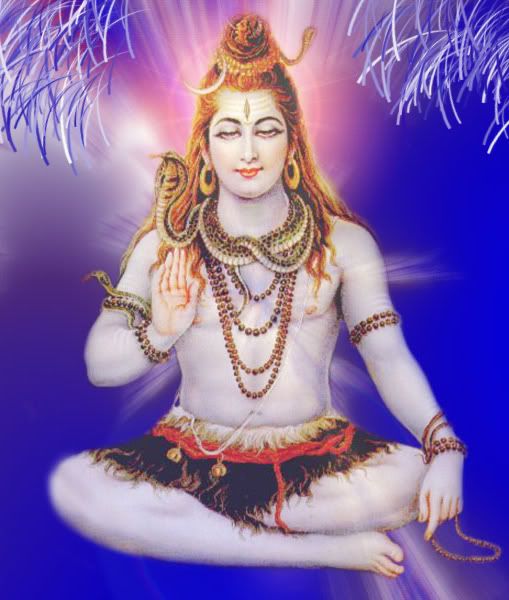 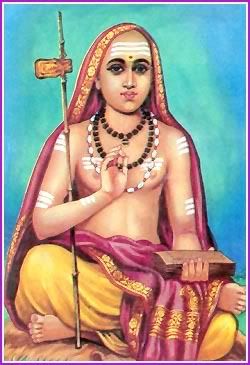 [/html:7b5c15ac3c] (1) Lord Gowthama Buddha, the Founder of Buddism, was born in Kapilawasthu, NEPAL. So when Buddhism sprouted in India at Gaya, Bihar... it expanded around fast and spread its wings to Nepal too. Some of the Buddhist mutts of such ancient days still exist even now... at Nepal, as a Standing-proof for this fact. [html:7b5c15ac3c] 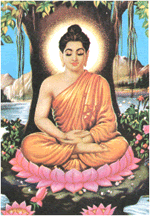 [/html:7b5c15ac3c](2) After the Kalinga war, the Emperor Ashoka embraced Buddhism and patronised it highly such that his whole Empire spread over almost the whole of North India became the domain of Buddhism... ..beating out Hinduism. Then the Buddhist Monks propogated Buddhism all over India... converting all the People to Buddhism, starting from the Kings. (3) Consequently due to lack of Patronisation, the Hinduism gradually became almost exrinct, until the advent of the Great Sankaracharya, who revived Hinduism, the Vedic Religion. (4) Adhi Sankaracharya took up a dynamic lead with a vow to rout out Buddhism and Jainism at the earliest, ...and Throne up Hinduism again at the earliest... Just within a short period of 16 years... He travelled all over India extensively alongwith his main disciple assistants... almost by foot... in search of each Religious Monk Leader of every Region in those hard days ...and challenged them on the Veracity and Viability of Buddhism in counter to Vedic Religion, so called Hinduism. Invariably Sankaracharya won over every Opponent Leader in the Debate and converted them back to Hinduism along with thousands of their disciples... ...conforming to the pre-conditions. Thus Hinduism got revived prominently in North India. (5) Then he took up South India, where Buddhism was firm-rooted with its Head-quarters at Kanchipuram. He determined to fight it out at its capital itself and so established his Headquarters at Kanchi, and achieved his goal, by defeating all the Kanchi mutt Buddhist heads too. Eventually the whole of South India too reversed back to Hinduism, only because of the Sole warfoot endeavour of the Great Sankaracharya....the INVINCIBLE of that era. (6) How Buddhism got spread.... out of India.? Because of Sankamithra the Daughter of Emperor Asoka... who travelled extensively out of India along with a Batch pf Monks and spread Buddhism... ....exploiting the widespread IGNORANCE, INNOCENCE and poverty of peasants... ...they could be converted from Hinduism (as per History -Not my Opinion) (7) If Sankaracharya would have set his feet... out of India too... Hinduism would not have lost its glory there, and Buddhism would have been wiped out almost radically out of India too.! (8) The main point of Sankaracharya against Buddhism was... that Buddhism is NOT AT ALL A RELIGION... ..but the Human Code of Conduct... of MORAL VALUES... ...and NOT BEYOND... towards the Soul aspects... as is necessary to be qualified as Religion. Because Buddhism is SOONYA VAADHA.... Does not clearly and pinpointedly speak about God, the Supreme Ruler of Universe. And even within Buddhism there exist lot of Self-contradictions. . ... it got split up into several splinters... conspicuously with the two prominent Branches as KEENA-YANA and MAHA-YANA Buddhist Monk- Heads of various divisions... used to constantly vie and oppose with each other... ....amongst themselves of one and the same Religion, Buddhism... ...which unhealthy trend helped Sankaracharya to rout out the whole of Buddhism easily.. ....one by one of contradictory divisions. (9) Concurrently Sankaracharya became cautious to safeguard Hinduism because of similar probable trend in Hinduism too.. ...by means of several Branches as Saivam, Saktham, Ganapathyam, Kaumaaram Sauram etc.. within One composite Vedic Religion Hinduism [html:7b5c15ac3c] 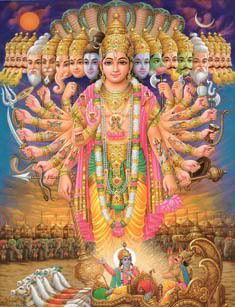 [/html:7b5c15ac3c]Hence Sankaracharya's second battle was to correct such a SICKLY MAN-MADE ATMOSPHERE within one and the same Religion... the Vedic Hindu Religion. So he went in search of each such Branch-heads, challenged them for debate and won over everyone of them invariably... Ultimately he established the VEDIC TRUTH.. that all those Six main Branches of ONE HINDU RELIGION... ....Comprising of various Sub-divisions... as Saivam, Saktham etc ..the the God-made branches of MOSAIC FORM... ...being WIDEST OPTIONS... made available, suiting to the individual Mind-set of the multi-faceted devotees. Rather they are the Branches of One Common Religion... Indirect Vaishnawam... with multi-paths.... ...leading towards ONE COMMON GOAL..... Paramathma NARAYANA... ..since Lord Narayana is the SUPREME VEDIC GOD... who has created several other Gods... ..through whom Narayana, so called Parameswara bestows His grace... as the Common Protecor Ruler for ALL HINDUS.. ...as categorically declared by Vedas. Vedic Sankara-Bashyam, Geetha-Bashyam and Sahasranama Bashyam of Sankaracharya firmly assert.... ....such an UNDISPUTABLE Vedic stand... quite clearly, undoubtedly and categorically. Ultimately Sankaracharya could unite all those Splinters of Hinduism within on fold of Vedic Religion, so called Hinduism. (10) But for the advent of the GREAT SEER Sankaracharya... the whole of India NOW would have been chanting... ...."Buddham charanam gachaami. Sangam charanam gachaami Dhammam charanam gachaami..!!!... ..similar to most of the present Thailand, Burma (Myanmar), Srilanka regions.,.. ...wherein the Great Mahaan... the Reincarnation (Awathara) of the God PARAMA-SHIVA Himself... ... as Adhi Sankarachrya.... did not ever set his sacred feet. .. . . |
|
|
|
|
#12 |
|
|
. I am really sorry to say this, this is nothing but fanatism from vaishnavites, as Far as I know sankaracharya does not refer to the supreme being as 'naryayna'. This Narayana became famous, thanks to our cult creator and brain washing founder 'A. C. Bhaktivedanta Swami Prabhupada during the 60's , it bacme cult amongst 'Gypsy' like americans in USA.. It was him and another film producer called 'Ramanand saagar' who bought this 'Narayana' concept, in the name 'International Society for Krishna Consciousness' As you are aware shaivites completley rejects the above theory! |
|
|
|
|
#13 |
|
|
. Pardon me, If I am wrong, didn't the Chola Monarchy rule south and central India during 'Adi Shankararchrya' period , ie. 7th century?? Chola's ruled burma, thailand, indonesia , malaysia, sri lanka and as far as Philipines??? Didn't they establish Shaivism there?? then how did budhism manage to survive in those places?? interestingly how did 'Islam' got spread 90% of Indonesia???? |
|
|
|
|
#14 |
|
|
.
.
I am really sorry to say this, this is nothing but fanatism from vaishnavites, as Far as I know sankaracharya does not refer to the supreme being as 'naryayna'. This Narayana became famous, thanks to our cult creator and brain washing founder 'A. C. Bhaktivedanta Swami Prabhupada during the 60's , it bacme cult amongst 'Gypsy' like americans in USA.. It was him and another film producer called 'Ramanand saagar' who bought this 'Narayana' concept, in the name 'International Society for Krishna Consciousness' As you are aware shaivites completley rejects the above theory! Dear Paramashiva, Welcome to differ with me. But please assert your stand by means of counter-points SPECIFICALLY.... ..quoting from Sankaracharya's works and Biography. . (7) If Sankaracharya would have set his feet... out of India too... Hinduism would not have lost its glory there, and Buddhism would have been wiped out almost radically out of India too.! . Sudhamm sir Pardon me, If I am wrong, didn't the Chola Monarchy rule south and central India during 'Adi Shankararchrya' period , ie. 7th century?? Chola's ruled burma, thailand, indonesia , malaysia, sri lanka and as far as Philipines??? Didn't they establish Shaivism there?? then how did budhism manage to survive in those places?? interestingly how did 'Islam' got spread 90% of Indonesia???? Chola Empire covered... partly South India, SriLanka, Burma (Myanmar), Singapore, Malaysia, Maldives, Indonesia and partly Philippines. In Indonesia there exists a River… named KAMPAR River… as a proof of the spread of the wings of Chola dynasty there too. Chola Empire was founded only in 8th century ruling over a large Empire for about 500 years upto 13th century Adhi Sankaracharya’s Life-period was just for 32 years during 788 – 820 A.D. ...prior to Chola’s period. No doubt, Cholas established Hinduism all through their Empire especially Saivam of Nayanmars. Sankaracharya was so much over-burdened during his very short Life-time... ...that he could not have any time to spare for taking up the task out of India too. .. |
|
|
|
|
#15 |
|
|
|
|
|
|
|
#16 |
|
|
I am really sorry to say this, this is nothing but fanatism from vaishnavites, as Far as I know sankaracharya does not refer to the supreme being as 'naryayna'. As you are aware shaivites completley rejects the above theory! Ultimately, the point is that it makes very little sense to project Shaivite-Vaishnavite sectarianism - which in its virulent form doesn't go much further back than the period of the Imperial Cholas - onto Adi Shankaracharya. It's about as absurd as trying to interpret the rivalry between the Cholas and Pandiyas in the light of DMK-AIADMK rivalry. Shankaracharya was not a sectarian Shaivite or a sectarian Vaishnavite, because sectarian Shaivism and Vaishnavism did not exist in his day, thank God. |
|
|
|
|
#17 |
|
|
1) Adi Shankaracharya born on :- 788 CE |
|
|
|
|
#18 |
|
|
Podalangai sir, I know he mentiones about Narayana, and all other names of God, but as Far as I know he does not refer naryana as 'Supreme being' he refers the supreme being as 'Parama Shiva' as far as I know |
|
|
|
|
#19 |
|
|
Ultimately, the point is that it makes very little sense to project Shaivite-Vaishnavite sectarianism - which in its virulent form doesn't go much further back than the period of the Imperial Cholas - onto Adi Shankaracharya. It's about as absurd as trying to interpret the rivalry between the Cholas and Pandiyas in the light of DMK-AIADMK rivalry. Shankaracharya was not a sectarian Shaivite or a sectarian Vaishnavite, because sectarian Shaivism and Vaishnavism did not exist in his day, thank God. |
|
|
|
|
#20 |
|
|
.
Conforming to Devotee's SELF-ASSIGNED Faith, Self-centred Perception... ...Mindset, Propensities, Imagination, Will and LOFTY WISHES.! ....although CONTRADICTORY amongst themselves.!!!
.... All this makes perfect sense if you understand what Adi Shankaracharya was trying to do Podalangai sir, I know he mentiones about Narayana, and all other names of God, but as Far as I know he does not refer naryana as 'Supreme being' he refers the supreme being as 'Parama Shiva' as far as I know [html:18b6fcc1a2]   [/html:18b6fcc1a2] First of all, I am unable to understand... ..why this UNNECESSARY discussion... ....amongst WE, THE FOLLOWERS... ....on who is the PARAMATHMA .... SUPREME GOD.... ....the Omnipotent ONE SUPER-COMMANDER over all other Gods. Hinduism is the only Religion which renders ample Freedom and Liberty to worship and believe any Vedic God as the Supreme, at the devotees own choice... and WILL. Yes. If a Saivite believes Lord Siva as the Supreme God / Paramathma... he / she is at Liberty to believe and worship so. Similarly a Shaaktha believes Shakthi or Kali as the Supreme Paramathma, he / she can worship and chant accordingly.... ...and parallelly the other Sectarians amongst the Six Sects... created by One Paramaathma Narayana... ..as Various Elementary paths towards One Common Goal... ...by Sauram, Gaanapathyam, Kaumaram, Saivam, Saaktham and SWAABHAAVIKAM. The Supreme God created for the convenience of Mosaic form of Humanity... ....seeking PRIVATE Options at the devotees own choice.. ...similar to various sorts of Food as Options.... while all of them render the same nutritions in different forms and Ingredients. Accordingly various Puranas... other than the common 18 Puranas... depict different Gods' Greatness... CONTRADICTING EACH OTHER... ..such as Muruga the Supreme... the Guru for Siva.... [html:18b6fcc1a2] 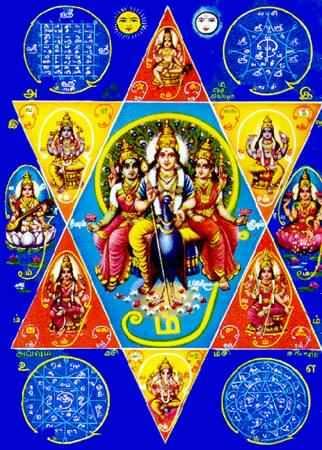 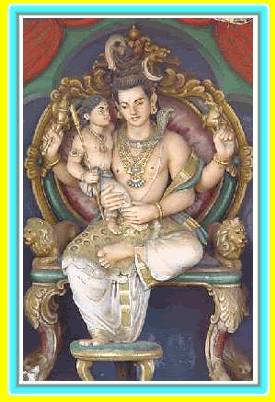 [/html:18b6fcc1a2] ...Ganesa the Prime God who created other Gods... ...Vishnu and Brahma searched for the Head and Feet of Siva and failed by Adi-mudi Kaanhaa padalam (as portrayed by Nayanmars).... ..Shakthi Parvathi was defeated by Nataraja, Siva... ...Shakthi maatha is the Supreme creator Ruler over Vishnu Siva and other Gods... ..who as Kali, defeated Lord Siva... [html:18b6fcc1a2] 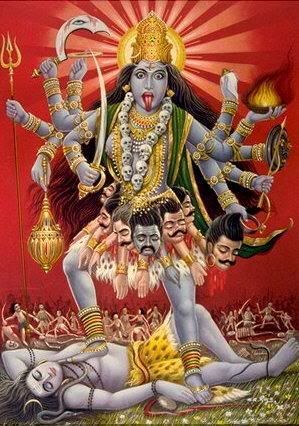 [/html:18b6fcc1a2]. ...and so on. ...to suit the specific sectarian's SELF-CENTRED WISHES... although they are the VARIOUS FALSE BELIEFS... ...since Not True... conforming to Vedas. So to mean... all these Six Sects are the various IMAGINARY FAITHS... as the tributary Feeder-paths.... ....towards the ULTIMATE ONE COMMON MAIN PATH ....VAISHNAWAM.... ....as clearly declared by Vedas. The most interesting part of Vedic Religion Hinduism is... that it renders as the Sixth Option named as... SWAABHAAVIKAM... By which the devotee can worship any Doll, Tree, Mountain, River or ANY OBJECT of his own making too.... as God... if he can believe it so. In such a case, the Supreme God enters into that Object and renders His Grace... ...making the Devotees Faith as True... even though a False belief. Vedas categorically assert that the Supreme Lord Paramathma is Narayana only... ....and Narayana only the PARAMESWARA in different forms and Names. Ramakrishna Paramahamsa, Krishna Chaithanya, Thukaram as well as even the German Scholar Dr Max Muller... have further clarified that Truth... in ONE VOICE. Sankaracharya too... has clearly asserted such a Vedic Truth as Narayana is the ONLY PARAMATHMA. [html:18b6fcc1a2] 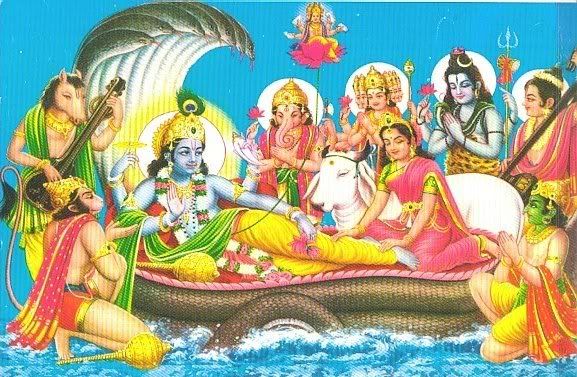 [/html:18b6fcc1a2] We can observe in Kerala Temples... even now-a-days... ...the devotees chant ACHA NARAYANA (Oh Father Narayana)... while entering Siva Temples ... and... ...AMMAE NARAYANA (Oh Mother Narayana)... while entering Shakthi temples... ...even if there may be NO SANNIDHI in those Temples... for GOD NARAYANA.! That is the traditional custom laid down by Adhi Sankaracharya... ...to ELIMINATE ANY PROBABLE CONFUSIONS.... in the minds of Devotees on the ONLY Paramathma NARAYANA... as per Vedas... ...who bestows grace through different Gods, Forms and Names as per individuals choice and wishes.! Vedic Religion Hinduism is extolled by Dr. Annie Besant, Dr Max Muller and several other International Scholars too... ....as the Great Religion... UNPARALLEL IN THE WORLD... ...mainly because of such WIDE OPTIONS... provided to cater to the varied individual devotees tastes and choices... ..conforming to the Devotee's own self-assigned Faith, Imagination and LOFTY WISHES.! ....although CONTRADICTORY amongst themselves.!!! . |
|
|
| Reply to Thread New Thread |
«
Previous Thread
|
Next Thread
»
| Currently Active Users Viewing This Thread: 1 (0 members and 1 guests) | |
|
|





 Hybrid Mode
Hybrid Mode

